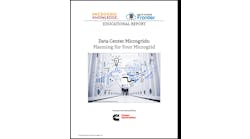In this week’s Voices of the Industry, Herman Chan, President of Sunbird Software, discusses the challenges of managing data centers in a world where cloud is king, what enterprise and colocation data centers can learn from the cloud, how to modernize data center operations to remain competitive — and how to operate you data center like a cloud provider.
Herman Chan, President of Sunbird Software
Modern data center environments are becoming increasingly complex and difficult to manage. Today’s data centers are bearing the resource burden of processing and storing massive amounts of data and applications brought on by the Internet of Things (IoT), big data, AI, and other trends. At the same time, enterprise data centers and colocation facilities need to address performance challenges such as latency and downtime due to human error and aging technology.
With these operational challenges and the resulting delays to IT resource provisioning, it’s no wonder that so many data center customers are moving to the cloud. After all, the cloud makes it fast and easy for IT to efficiently deploy data and applications in real time. Enterprise data centers and colocation facilities are attempting to keep pace, but simply adapting to changing conditions in your data center is not enough to keep your customers happy. For that, you need to operate like a cloud provider.
What Can Enterprise Data Centers Learn from the Cloud?
In today’s world where cloud is king, what customers want is agile, scalable IT. Traditional, slow deployment of IT resources is no longer relevant. It has been replaced by the subscription-based, on-demand “as a service” model that enables customers to pay-as-they-go for technology and services without owning the infrastructure, software, or platform. Additionally, customers don’t want to worry about storage or maintaining hardware, servers, network cabling, or other equipment. Instead, they’re looking for IT resources that can be increased or decreased on demand, without a noticeable impact to performance. Customers want these resources no matter where they themselves are located geographically, and the cloud can deliver anywhere at any time.
[clickToTweet tweet=”Herman Chan – In today’s world where cloud is king, what customers want is agile, scalable IT. #datacenters” quote=”Herman Chan – In today’s world where cloud is king, what customers want is agile, scalable IT. #datacenters”]
Competing against the advantages of the cloud can seem daunting. How can enterprise data centers and colocation facilities become more agile so they provision faster and keep their customers happy?
Many data center managers believe that the answer lies in modernizing their data centers—deploying new infrastructure and increasing their use of intelligent PDUs, smart devices, and sensor data. However, such actions only address part of the equation. To provision at the speed of IT, enterprise and colocation data centers need to modernize not only their assets and facilities but also their operations.
Tools to Help You Run Your Data Center Like a Cloud Provider
The keys to operating like a cloud provider lie in effective asset management and capacity planning. Leveraging the right tools is critical to answering questions around how you deploy equipment, provision services, and get applications up and running faster. To run your data center with the efficiency and resiliency to provide a cloud-like experience, you need tools that address the following challenges:
- Identifying capacity for your new assets. Finding capacity for assets is one of the most time-consuming aspects of provisioning new equipment. As a result, it can limit your agility and responsiveness to new requests for IT resources. Most data center management tools only provide lists of assets, without the capability to determine their capacity needs. Intelligent capacity search functionality, which allows you to identify and reserve not only space but also power and network capacity, is a tool that can dramatically reduce the time needed to locate, plan, reserve, and provision new capacity and equipment for services.
[clickToTweet tweet=”Herman Chan – Traditional enterprise data centers and colocation facilities need to modernize their operations to enable provisioning at the speed of IT, or risk being left behind. ” quote=”Herman Chan – Traditional enterprise data centers and colocation facilities need to modernize their operations to enable provisioning at the speed of IT, or risk being left behind. “]
- Locating assets quickly. Modern data center environments can extend across a wide range of locations, from owner-operated edge sites to colocation facilities. Data center managers need to be able to manage all assets, even when they’re not on site. A floor map that allows you to search and visualize assets increases productivity by helping you see exactly where they are located so you can direct technicians to complete work orders in remote locations. You can also use a floor map asset search to determine which equipment is required for a specific application, allowing you to add or remove assets as necessary and to know the impact of maintenance or downtime on mission-critical services. Seeing visual cable trace routes on the floor map also helps you instantly understand how your assets are connected, down to the port-level.
- Predicting the effect of changes on your data center before they happen. Reacting to IT resource demand and using basic metrics to plan capacity are no longer sufficient to keep pace with the cloud. Instead, data center managers need more advanced analytics that enable them to predict the net impact of future projects on data center capacity. Using what-if and predictive analytics to analyze upcoming additions and decommissions can help you quickly and accurately determine if you can delay capital expenditures or if you need to purchase more assets to avoid a shortfall of resources.
- Managing the health and status of all your data centers at a glance. Along with asset and capacity management, power and environmental monitoring is important for IT resource deployment as well. Power and environmental data helps you avoid overprovisioning so you can be more energy efficient by increasing temperature set points. Monitoring power and cooling capacity at a granular level also enables you to find the right balance of saving energy and money without introducing risk and compromising uptime and availability.
- Tracking time to provision/decommission assets to ensure that you’re meeting SLAs. Service-level agreements (SLAs) can be difficult to meet in complex environments where there are different requirements for application availability and uptime. To support SLAs that guarantee speed and availability for services, consider a change management dashboard with Key Performance Indicators (KPIs) specific to change requests. This tool will help you ensure that the changes required to support customer demand are made in a timely manner and as specified so you can provision resources faster. It can also help you identify potential issues in how work orders and requests are completed so you can address them before they become problems.
- Answering common data center questions instantly. Trying to field questions from management, customers, and other teams is challenging when you don’t have the data you need at your fingertips. Having data center business intelligence dashboards and reporting capabilities built-in to your data management software helps you save time on analysis and extract the information that matters most for helping you do your jobs more effectively. With the right data, you can reduce complexity, become more agile, and ultimately improve your data center operations.
These challenges are difficult to address with legacy tools like spreadsheets and CAD drawings. Even early attempts at data center management software do not provide the speed, advanced capabilities, and granular analytics required for modern data center environments. Today’s data center managers need second-generation Data Center Infrastructure Management (DCIM) software that meets the requirements of modern data center environments and leverages new technology to maintain uptime, drive efficiency, and boost productivity.
Bringing It All Together
Modern data center customers have more alternatives than ever before for data processing and storage. However, whether they choose a traditional data center, colocation facility, private or public cloud provider, or a hybrid environment, customers want agile deployment of IT resources to process and store the data and applications they need for business innovation.
Traditional enterprise data centers and colocation facilities need to modernize their operations to enable provisioning at the speed of IT, or risk being left behind. To do so, they need to focus on better asset and capacity management to convince customers that they can provide the same speed, efficiency, and reliability associated with a cloud provider. A modern data center management solution like second-generation DCIM software can help data center managers address their key challenges and leverage tools to help them meet IT resource demand easily—just like a cloud provider.
Herman Chan is President of Sunbird Software.





